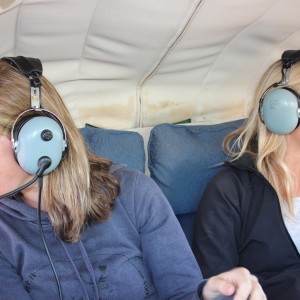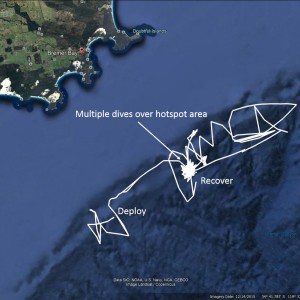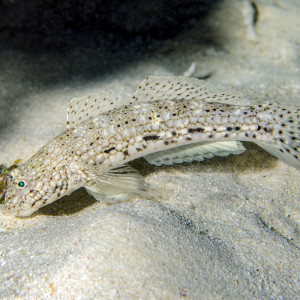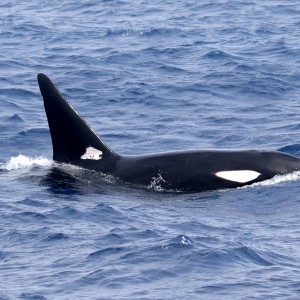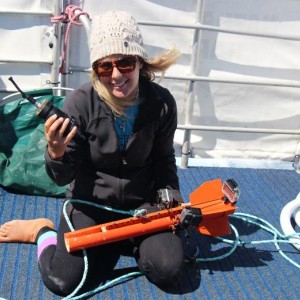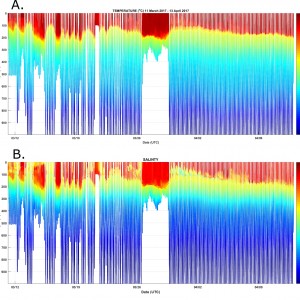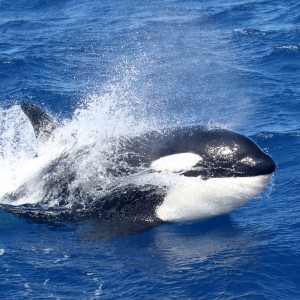Onboard observers scan the ocean surface in search of wildlife during aerial surveys. Left to right: Verity Steptoe, Rebecca Wellard.
Senior field technicians Jem Turner, Louis Masarei and Adam Jolly prepare baited camera equiptment before deployment in the Bremer Marine Park.
A cock-eyed squid (Histioteuthis miranda) investigates a baited camera unit.
Google Earth image of the glider track in white from deployment to recovery. Glider tracks can look like "Mr Squiggle" drawings. This is because the gliders are propelled only by a buoyancy engine and their movement can be overpowered by strong ocean currents. In the latter part of the mission, the glider returned to the hotspot area where it did multiple dives before it was recovered.
 by Paul Thomson
by Paul ThomsonIstigobius decoratus, known as the Decorated Sandgoby is found on sand patches near reefs.
 by Ian Shaw
by Ian ShawA pod of killer whales (Orcinus orca) surfaces beneath the plane during an aerial survey of the Bremer canyon.
A pilot fish, Naucrates ductor, attracted to a pelagic BRUVS in the Bremer marine region.
Pleurosicya mossambica also known as the toothy goby or the Mozambique ghost goby is found on many substrates, including corals, sponges, giant clams and seaweeds, and can vary colour according to the substrate.
 by Ian Shaw
by Ian ShawDr. Paul Thompson from the University of Western Australia and the Integrated Marine Observing System prepares the Sea Glider for its mission. Mission preparation involves simulated glider dives on the deck prior to deployment to ensure all systems and sensors are operational.
 by Paul Thomson
by Paul Thomson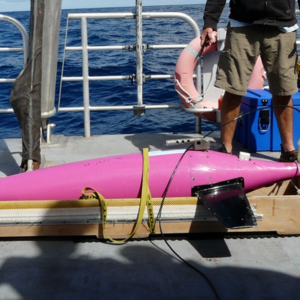
Dr. Paul Thomson from the University of Western Australia and the Integrated Marine Observing System prepares the Sea Glider for its mission. Mission preparation involves simulated glider dives on the deck prior to deployment to ensure all systems and sensors are operational.
 by Paul Thomson
by Paul ThomsonPhD candidate Rebecca Wellard prepares to deploy a towed acoustic logger.
Tagging ocras in the Bremer marine region, (a) the research team approaching a male orca and (b) a successful biopsy sample of an adult orca in the Hood Canyon on March 19, 2017.
This figure shows (a) seawater temperature and (b) seawater salinity from the surface to 1000 metres depth during the Bremer Bay canyon glider mission. Patterns of seawater temperature and salinity (and therefore density) can reveal a lot about the structure of the ocean currents in a region. This figure shows relatively warm, eastward flowing Leeuwin current water down to about 200 metres depth, which overlays colder water of the Flinders Current and Antarctic Intermediate Water.
 by Paul Thomson
by Paul ThomsonThis killer whale is known at Tarni (WA089). Tarni has been catalogued since 2014 by Project ORCA, a research initiative that investigates the distribution, abundance, bioacoustics and population dynamics of killer whales in Australian waters. The Bremer Marine Park is a known hotspot for this species, and one of the primary study sites for Project ORCA. Tarni, easily recognisable by the nick in the tip of the dorsal fin and and "X" scarring on the saddle patch, was named after the Australian Indigenous word meaning "surf or wave" in the Kaurna language. An appropriate name as Tarni is regularly seen surfing the wake of our research vessel or charging through the big swell in the Bremer region.
Wildlife and oceanographic surveys of the Bremer Marine Park. The Bremer Marine Park was sampled as part of a collaborative government funded program designed to provide critical baseline information on the presence of marine megafauna in the region and the potential physical factors affecting their distribution. Multiple sampling platforms were used, including visual transects conducted from the air (black), drifting underwater camera traps (known as stereo-BRUVS, dark blue), passive acoustic recordings (orange) and water profiles obtained from an autonomous deep-diving Seaglider (yellow). Large sharks (1), cetaceans (2) and molluscs (3) were among the species encountered within and outside the park boundaries.

